Nicole schreibt...
Santorini 2020 |
 |
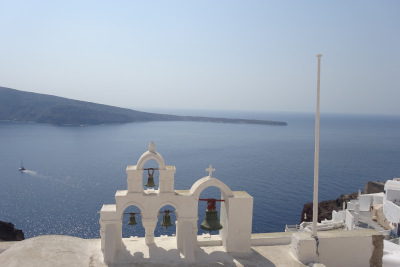 Not surprisingly the worldwide Corona pandemic turned all my travel plans for 2020 upside down. Not just mine of course and one rather convenient result was the complete stop of all cruises, which I've come to detest in recent years with their ever-bigger ships disgorging ever bigger crowds into small places causing massive overtourism problems without contributing to the local economy at all.
Not surprisingly the worldwide Corona pandemic turned all my travel plans for 2020 upside down. Not just mine of course and one rather convenient result was the complete stop of all cruises, which I've come to detest in recent years with their ever-bigger ships disgorging ever bigger crowds into small places causing massive overtourism problems without contributing to the local economy at all.Which made me think that this was the perfect chance to visit the picturesque Greek island of Santorini, a staple of all Eastern Mediterranean cruises and thus constantly overrun by thousands of sheeple crowding the small streets of the capital Fira and the few sights. And luckily Greece (usually not known for amazing organisational skills) had managed the pandemic very well and kept numbers low, so we could travel to Santorini with very little fuss. Aegean Airlines tempted us with a great offer where the second passenger pays only half-price and thus being about half as expensive in total as Eurowings and their rip-off prices. Even if it meant going via Athens and worrying slightly over Greece's new entry procedures that could see passengers plucked off for random Corona tests and sent into 24 hours quarantine until the result comes in.
Düsseldorf Airport, usually so busy, ressembled a ghost town, which was rather depressing to see. Also depressing was the fact that the airlines are indeed allowed to cram planes full in order to make flights viable while theatres are killed with all sorts of ridiculous rules, but that's another subject for another rant. We had won the Greek Corona Lottery by getting QR Codes with the "right" number for entry, so no Corona tests for us. Instead we were sent on a circuitous route through Athens Airport and security again to make it to the departure gate. The flight to Santorini was an odd dream coming true as I had always hoped to fly Olympic Airways some day just for the name alone. But the official Greek airline went bust some years ago and was re-invented as Aegean Airlines - but I hadn't known they kept the name and logo of Olympic alive for domestic flights and we flew Olympic on a small twin prop to Santorini, where we arrived after dark.
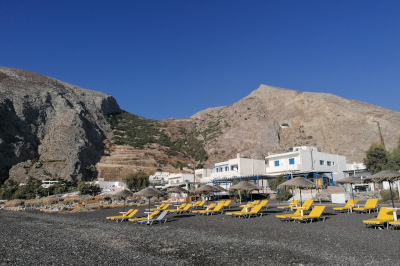 We had chosen a hotel on Kamari Beach, the quieter of the two resorts on the East coast of the volcanic island, which has at least some pebbly beaches and which turned out to be a perfect choice with its pedestrianized beach promenade lined with hotels, restaurants and shops. I was quite surprised by how busy it was with tourists, all things considered, and happy for the lovely Greeks, whose hospitality and friendliness I have always greatly appreciated.
We had chosen a hotel on Kamari Beach, the quieter of the two resorts on the East coast of the volcanic island, which has at least some pebbly beaches and which turned out to be a perfect choice with its pedestrianized beach promenade lined with hotels, restaurants and shops. I was quite surprised by how busy it was with tourists, all things considered, and happy for the lovely Greeks, whose hospitality and friendliness I have always greatly appreciated.Initially the first day was supposed to be a quiet day on the beach doing nothing, but by noon the mother got jumpy and I suggested going up to Ancient Thera. You can see the serpentine street winding its way up in the photo and her not so surprising reaction was "if you think I'll walk up there you got another thing coming". Which meant she was forking out for a cab to take us to the top of the 360 metre tall Mesavouno, which was fine by me.
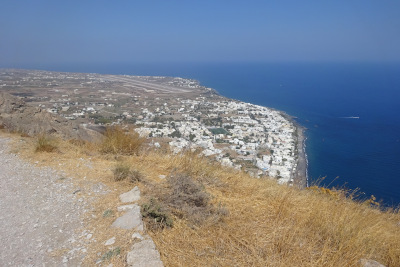 Here's the view from the top over Kamari and the airport basically next door. Now for history lesson no.1: Thera was founded in 9th century BC by colonists from Sparta who called the island and city after their first mythical ruler Theras. The settlement pottered on for several centuries until a minor volcanic eruption covered it in 726 and people gave up what was left of it. A German dude with the impressive name of Friedrich Hiller von Gaertringen started digging around on top of the Mesavouno in 1895 and discovered the ruins of the city which are now known as Ancient Thera.
Here's the view from the top over Kamari and the airport basically next door. Now for history lesson no.1: Thera was founded in 9th century BC by colonists from Sparta who called the island and city after their first mythical ruler Theras. The settlement pottered on for several centuries until a minor volcanic eruption covered it in 726 and people gave up what was left of it. A German dude with the impressive name of Friedrich Hiller von Gaertringen started digging around on top of the Mesavouno in 1895 and discovered the ruins of the city which are now known as Ancient Thera. As so often with these ruins, not much is left, stretching the imagination to breaking point, but the location alone is utterly stunning. It must have been amazing to watch performances in that theatre against such a gorgeous background.
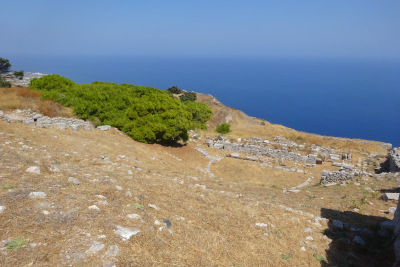
|
 |
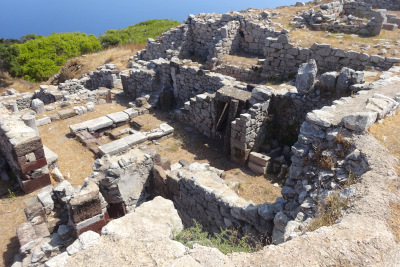
|
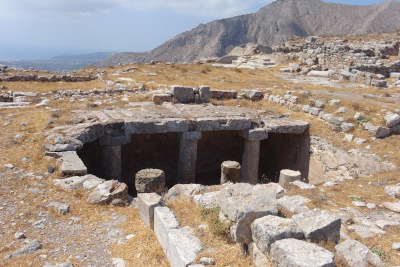 |
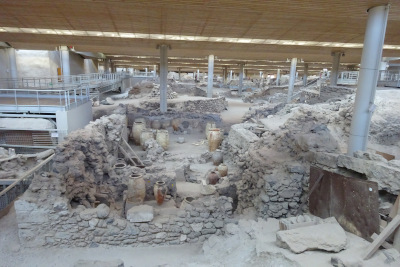 Speaking of volcanic eruptions, the one in 726 AD was a minor side show. The main event had taken place almost 2,000 years earlier and to follow its traces, we rented a car next morning to drive to Akrotiri at south-western end of Santorini. This settlement had flourished parallel to the Minoan settlement on Crete around 3000 BC, the same time as the Pharaohs ruled Egypt.
Speaking of volcanic eruptions, the one in 726 AD was a minor side show. The main event had taken place almost 2,000 years earlier and to follow its traces, we rented a car next morning to drive to Akrotiri at south-western end of Santorini. This settlement had flourished parallel to the Minoan settlement on Crete around 3000 BC, the same time as the Pharaohs ruled Egypt. But in 16th century BC (the date is still not known) the volcano produced one of the greatest volcanic eruptions in human history, taking most of what was the ancient island (then called Strongyle, the round one) down into the sea with it. It is thought that the following tsunami flooded the Northern coast of Crete 60 miles south so badly that it destroyed its settlements including the famous Minoan palace at Knossos and basically the entire Minoan culture. The more delicious myth is of course that the ancient town that sank to the bottom of the sea in what's now Santorini was Platon's fabled Atlantis. Another fascinating theory that does more or less fit the timeline is that the seven plagues of ancient Egypt that forced Pharaoh to let Moses and his people go, were all results of the volcanic eruption as well.
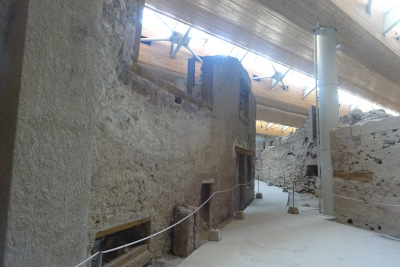 Whether it's all true or just fanciful humbug, who knows? Akrotiri is still a fascinating place to visit. It was completely buried under ashes during the eruption and thus, much like Pompeii after the eruption of Mount Vesuvius, got amazingly well preserved. To faciliate excavations, a massive roof has been built over the site (this is the second one, by the way, the first one caved in and killed a hapless Welsh tourist some years ago), but you can walk around and even through parts of the Bronze Age settlement again now.
Whether it's all true or just fanciful humbug, who knows? Akrotiri is still a fascinating place to visit. It was completely buried under ashes during the eruption and thus, much like Pompeii after the eruption of Mount Vesuvius, got amazingly well preserved. To faciliate excavations, a massive roof has been built over the site (this is the second one, by the way, the first one caved in and killed a hapless Welsh tourist some years ago), but you can walk around and even through parts of the Bronze Age settlement again now.Here are the well preserved fronts of houses in Triangle Square, which are still only half-way exposed and were up to three stories high. While most of what was found on site has been brought to the museum in Fira, there's still bits and pieces to see like the pithoi pots for storage and even ancient furniture like beds and tables. While it's not as impressive as Pompeii by a mile, it was still oddly fascinating to walk through streets (of sorts) that were busy 3,500 years ago, not to mention the idea that this might have been a part of the legendary Atlantis (and the main draw for me to go to Santorini in the first place).
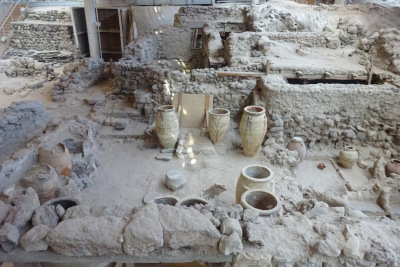
|
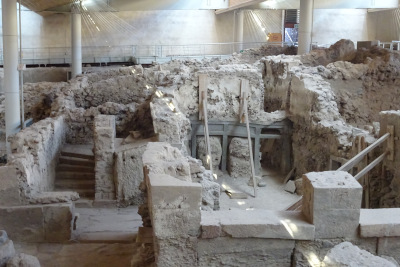 |
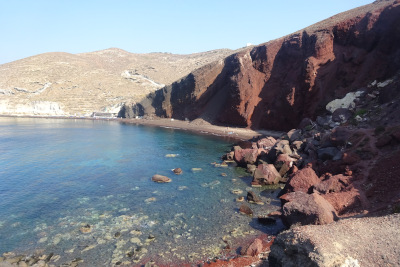
|
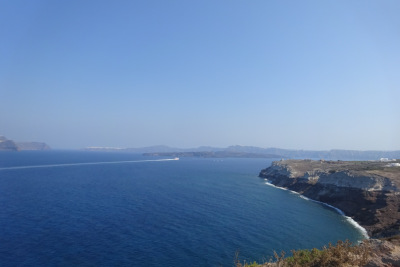 |
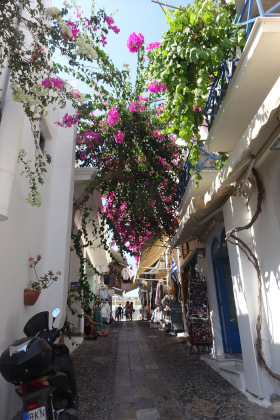 Santorini is rightly famous for the villages perched on the rim of the caldera, where people used to dig caves into the soft volcanic stone to make their homes in. These days it's mostly luxury hotels aiming for honeymooners with more money than sense who like booking suites with private little pools the size of bathtubs built into the hillside.
Santorini is rightly famous for the villages perched on the rim of the caldera, where people used to dig caves into the soft volcanic stone to make their homes in. These days it's mostly luxury hotels aiming for honeymooners with more money than sense who like booking suites with private little pools the size of bathtubs built into the hillside. The island's capital Fira is bang in the middle of the island and considering the amount of day trippers shoving their way through the small alleys I was happier than ever that I seized the chance to experience Santorini without cruise sheeple. Usually there are 2-3 swimming hulks at anchor in the caldera, disgorging around 5,000-6,000 people into Fira by tender boat. There's a small cable car to get them uphill with waiting times up to an hour and the only other options are to either walk the nearly 600 steps uphill or pay for one of the poor unfortunate mules to carry them uphill (you can see both cable car and serpentine street below), a godawful practice I hope will end some day, just as Santorini needs to get to grips with overtourism like other places in the Mediterranean that just can't deal with the ever-growing masses of today's stupidly oversized cruise ships.
Though even with the sheeple absent, I still found people to get annoyed about: Idiotic Instagram girlies, spending hours posing and clogging up traffic in the small alleyways. I tend to be respectful of other tourists wanting to get their great shots, but these narcissistic idiots pissed me off so much, I didn't care about walking into their 1001 pictures of themselves in front of the scenery.
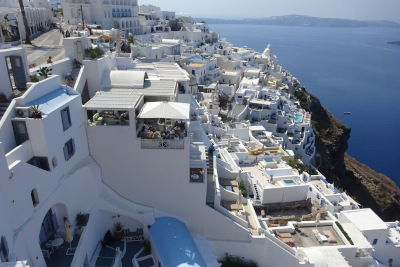
|
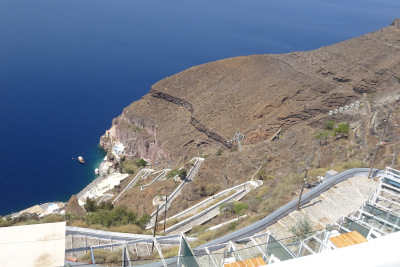 |
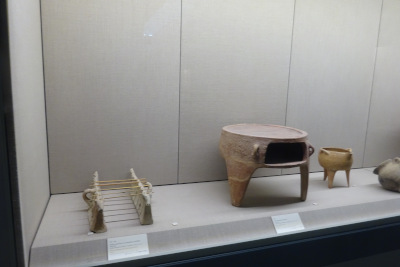 But let's not be negative, because Fira is way too beautiful for that. After a first stop at a lounge bar both for refreshments and to enjoy the fabled view (clearly priced into the drinks!) we walked along the main street to the Prehistoric Museum of Thira, where the stuff found in Akrotiri is on display. Among the more fascinating things were (for me) this really ancient baking oven and barbecue tray that really don't look all that different from how we prepare food today. There was also a single golden ibex figure, found hidden under floor boards and I've been wondering ever since who hid that and why. Surely there's a blockbuster movie in this about the volcanic eruption, the population fleeing Atlantis and someone hiding his most precious possession... Another interesting sight were the well-kept frescoes, shielded by all the ash for millennia. Some are now at the National Museum of Athens, but some were on display here:
But let's not be negative, because Fira is way too beautiful for that. After a first stop at a lounge bar both for refreshments and to enjoy the fabled view (clearly priced into the drinks!) we walked along the main street to the Prehistoric Museum of Thira, where the stuff found in Akrotiri is on display. Among the more fascinating things were (for me) this really ancient baking oven and barbecue tray that really don't look all that different from how we prepare food today. There was also a single golden ibex figure, found hidden under floor boards and I've been wondering ever since who hid that and why. Surely there's a blockbuster movie in this about the volcanic eruption, the population fleeing Atlantis and someone hiding his most precious possession... Another interesting sight were the well-kept frescoes, shielded by all the ash for millennia. Some are now at the National Museum of Athens, but some were on display here:

|
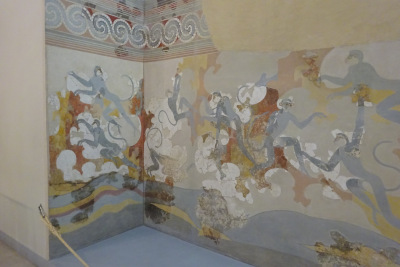 |
 And here the archaeological tour of Santorini ended. After some more strolling through Fira and peeking into the Orthodox Cathedral we had an extremely delicious and reasonably priced lunch in a tavern without Caldera view, then moved on to the last stop, Oia at the northern tip.
And here the archaeological tour of Santorini ended. After some more strolling through Fira and peeking into the Orthodox Cathedral we had an extremely delicious and reasonably priced lunch in a tavern without Caldera view, then moved on to the last stop, Oia at the northern tip. It is here where the most famous photos of Santorini are taken (those with the two blue-domed churches), but what nobody tells you is that the approach to Oia (pronounced Ee-ah by the way and not Oy-ah) is absolutely chaotic and nothing is ever signposted. Once you had muddled through and been up and down several staircases and alleys and found the lookout at last, it WAS impossibly beautiful indeed and far less crowded than Fira. Most people come to Oia for the famous sunset for which it was far too early. So here are the two most famous island views of Santorini:
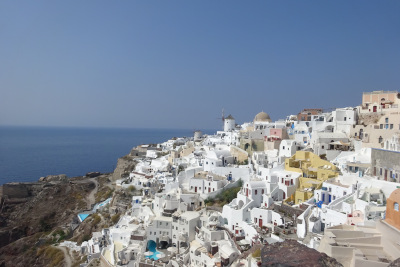
|
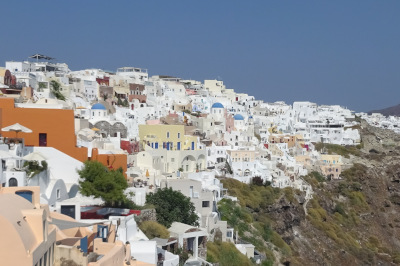 |
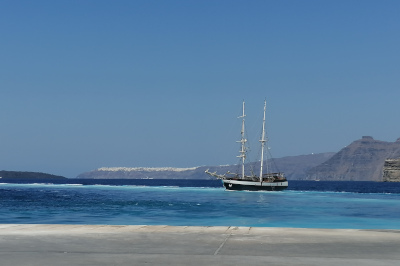 Since we had already booked a sunset cruise anyway, we didn't linger, but returned to Kamari to digest the long busy day.
Since we had already booked a sunset cruise anyway, we didn't linger, but returned to Kamari to digest the long busy day.The cruise should have happened the next day but was cancelled/postponed due to heavy winds in the caldera, which gave me a gorgeous full day of doing nothing at the beach, followed by another morning of doing nothing, before we were picked up after lunch time.
Why so early when it's a sunset cruise? Well, they did have an interesting schedule. First we went to the modern port of Santorini, which can only be reached down a mad serpentine street (which made me feel sorry for hapless newcomers arriving by ferry and taking a rental car without knowing what's waiting for them) and where we boarded our ship, the lovely two-mast bark Thalassa.
Our first stop was actually the port of Fira, where we picked up two more passengers and which gave me a great opportunity to see the city from below as well. Then we crossed the caldera to Nea Kameni, which could be considered the proper volcano and is now an uninhabited island and geothermal park. After the massive Minoan eruption sunk the middle of the island, leaving what's now still visible, there was just the sea for a long time. Then the Romans reported that a new tiny island had appeared close to Thera and over several smaller eruptions along the centuries (the last one dating from 1950) the volcano coughed up more bits of earth and lava without so much as disturbing the locals at their morning coffee. And while I had been on top of a volcano earlier this year on Lanzarote, it wasn't half as intense as this feeling now. We actually saw (and smelled) steam rising through crevices in the ground and could hold our hands into an opening that felt like one of those hot air dryers in toilets. The island is dotted with research stations and measuring instruments to make sure the locals are alerted if the volcano wakes up again. Here's a view of the main crater as well as a look over different kinds of rocks towards Santorini proper:
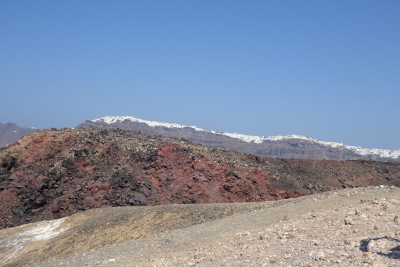
|
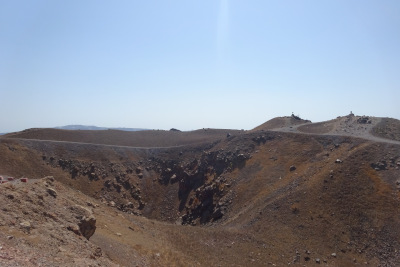 |
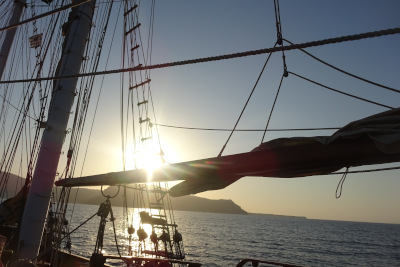 After this fascinating lesson in geology we stopped again for a swim at the Hot Springs, which were neither hot nor a spring, just a pretty little inlet at Nea Kameni, but it was nice to cool off in the water for a while. Afterwards we sailed around Nea Kameni to Therasia, where people could go for another swim right off the ship while a barbecue was prepared on board. It was all very leisurely and lovingly done and the old sailing ship geek in me was having a ball.
After this fascinating lesson in geology we stopped again for a swim at the Hot Springs, which were neither hot nor a spring, just a pretty little inlet at Nea Kameni, but it was nice to cool off in the water for a while. Afterwards we sailed around Nea Kameni to Therasia, where people could go for another swim right off the ship while a barbecue was prepared on board. It was all very leisurely and lovingly done and the old sailing ship geek in me was having a ball. Finally it was off to Oia for the fabled sunset. Dear reader, what can I say. Tourist hype is tourist hype. Yes, it was a pretty sunset, but I've seen better without half as much fuss. So here's the gorgeous sunset, perfect for showing off on Instagram and here's also the other side of the medal, an impressive pile up of traffic on land, amusing to watch from our ship. Nonetheless, the Sunset Cruise was a wonderful outing worth every cent spent on it.
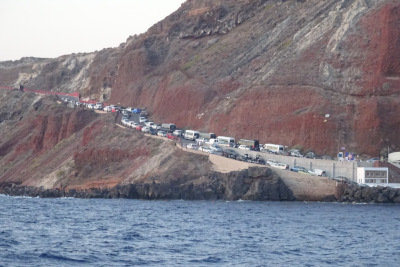
|
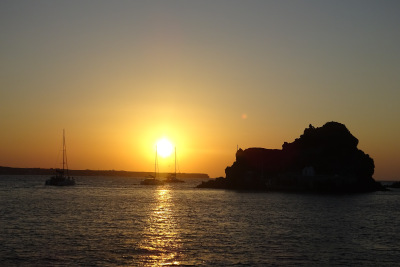 |

It was also the perfect ending to what was pretty much a perfect trip. Santorini truly deserves all the accolades for being impossibly picturesque in the traditional Cycladic style with very little of the usual blight of mass tourism in evidence and for the typical warm Greek hospitality. And I was happy for me that I got a proper holiday out of this messed-up summer after all and at least I can now live on these wonderful memories in the dreary months to come...
Copyright © All Rights Reserved